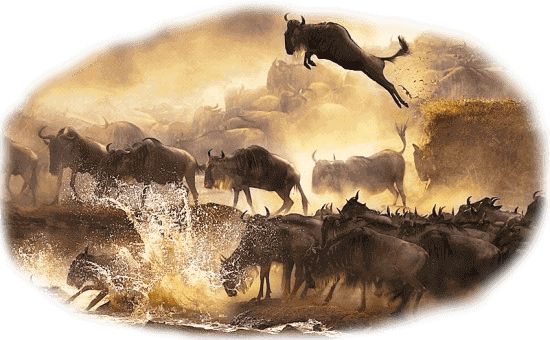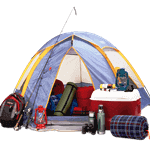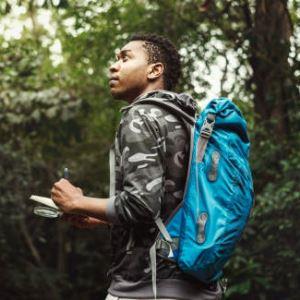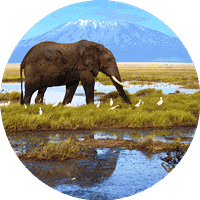 Kenya is a dream destination for New Zealand travelers looking to explore rich wildlife, dramatic landscapes, and vibrant cultures. This East African nation is famed for its sprawling savannahs, abundant game reserves, and cultural diversity that captivates every type of adventurer. Whether you're planning your first safari or seeking unique cultural immersion, Kenya promises unforgettable experiences. Timing is everything when it comes to travel, and Kenya’s seasons play a crucial role. For wildlife lovers, the dry months of June to October and January to February are ideal. During this period, the animals are easier to spot as they gather near water sources. One of the most spectacular events on the planet, the Great Migration, unfolds in the Masai Mara from July to October. Witnessing thousands of wildebeest and zebras crossing the plains is a memory that lasts a lifetime. New Zealand visitors should make time to explore Kenya’s top safari parks. The Masai Mara National Reserve is a must-visit, not just for the migration but for year-round sightings of the Big Five. Amboseli National Park, with its stunning backdrop of Mount Kilimanjaro, is ideal for elephant sightings. Tsavo East and West National Parks also offer unique landscapes and fewer crowds, making for a more intimate safari experience. Entry into Kenya for New Zealand citizens is straightforward. An eVisa is required and can be easily obtained online before departure. Travelers are advised to ensure their passports are valid for at least six months from the date of entry. Health precautions, such as the yellow fever vaccination and carrying mosquito repellent, are important for a safe trip. Sticking to bottled or filtered water is also a smart move. Cultural experiences in Kenya are just as enriching as its wildlife. From visiting traditional Maasai communities to enjoying flavorful Swahili dishes on the coast, there’s no shortage of ways to connect with the local way of life. Nairobi, the bustling capital, offers museums, art galleries, and markets that showcase Kenya’s vibrant urban culture. For relaxation, the pristine beaches of Diani and Lamu offer a perfect end to any Kenyan adventure. This Kenya travel guide for New Zealand citizens is your starting point for a journey filled with natural beauty, warm hospitality, and countless adventures. From the bustling capital of Nairobi to the serene shores of the Indian Ocean, every corner of Kenya offers a distinct experience. Adventure-seekers can trek through lush forests, hike Mount Kenya, or enjoy hot air balloon rides over the vast savannah. Wildlife lovers will find themselves in paradise, with game drives offering up-close views of animals in their natural habitats. The thrill of seeing a lion hunt at dawn or a herd of elephants bathe at sunset is unmatched. Beyond the wilderness, Kenya's people are just as captivating. Engaging with local communities, such as the Maasai and Samburu, gives travelers a chance to understand age-old traditions and the values that define Kenyan identity. Whether you're navigating the busy stalls of a Nairobi market or watching the stars in the remote Laikipia Plateau, the contrast and charm of Kenya will stay with you. Each moment is a story, each view a postcard. Kenya is more than just a destination it's a vibrant, living tapestry of life, land, and legacy waiting to be explored by New Zealand adventurers.
Kenya is a dream destination for New Zealand travelers looking to explore rich wildlife, dramatic landscapes, and vibrant cultures. This East African nation is famed for its sprawling savannahs, abundant game reserves, and cultural diversity that captivates every type of adventurer. Whether you're planning your first safari or seeking unique cultural immersion, Kenya promises unforgettable experiences. Timing is everything when it comes to travel, and Kenya’s seasons play a crucial role. For wildlife lovers, the dry months of June to October and January to February are ideal. During this period, the animals are easier to spot as they gather near water sources. One of the most spectacular events on the planet, the Great Migration, unfolds in the Masai Mara from July to October. Witnessing thousands of wildebeest and zebras crossing the plains is a memory that lasts a lifetime. New Zealand visitors should make time to explore Kenya’s top safari parks. The Masai Mara National Reserve is a must-visit, not just for the migration but for year-round sightings of the Big Five. Amboseli National Park, with its stunning backdrop of Mount Kilimanjaro, is ideal for elephant sightings. Tsavo East and West National Parks also offer unique landscapes and fewer crowds, making for a more intimate safari experience. Entry into Kenya for New Zealand citizens is straightforward. An eVisa is required and can be easily obtained online before departure. Travelers are advised to ensure their passports are valid for at least six months from the date of entry. Health precautions, such as the yellow fever vaccination and carrying mosquito repellent, are important for a safe trip. Sticking to bottled or filtered water is also a smart move. Cultural experiences in Kenya are just as enriching as its wildlife. From visiting traditional Maasai communities to enjoying flavorful Swahili dishes on the coast, there’s no shortage of ways to connect with the local way of life. Nairobi, the bustling capital, offers museums, art galleries, and markets that showcase Kenya’s vibrant urban culture. For relaxation, the pristine beaches of Diani and Lamu offer a perfect end to any Kenyan adventure. This Kenya travel guide for New Zealand citizens is your starting point for a journey filled with natural beauty, warm hospitality, and countless adventures. From the bustling capital of Nairobi to the serene shores of the Indian Ocean, every corner of Kenya offers a distinct experience. Adventure-seekers can trek through lush forests, hike Mount Kenya, or enjoy hot air balloon rides over the vast savannah. Wildlife lovers will find themselves in paradise, with game drives offering up-close views of animals in their natural habitats. The thrill of seeing a lion hunt at dawn or a herd of elephants bathe at sunset is unmatched. Beyond the wilderness, Kenya's people are just as captivating. Engaging with local communities, such as the Maasai and Samburu, gives travelers a chance to understand age-old traditions and the values that define Kenyan identity. Whether you're navigating the busy stalls of a Nairobi market or watching the stars in the remote Laikipia Plateau, the contrast and charm of Kenya will stay with you. Each moment is a story, each view a postcard. Kenya is more than just a destination it's a vibrant, living tapestry of life, land, and legacy waiting to be explored by New Zealand adventurers.
Quick Reference Table for New Zealand Travelers to Kenya
| Topic | Details for New Zealand Travelers |
|---|---|
| Best Travel Months | June to October, January to February |
| Visa Requirement | eVisa required, apply online |
| Wildlife Hotspots | Masai Mara, Amboseli, Tsavo East & West |
| Cultural Highlights | Maasai villages, Swahili food, Nairobi markets |
| Health Tips | Yellow fever vaccine, mosquito repellent, bottled water |
| Local Time Difference | Kenya is 9 hours behind New Zealand |
| Recommended Travel Duration | 10 to 14 days for a well-rounded experience |
Best Time to Visit Kenya for New Zealand Wildlife Enthusiasts
For New Zealand wildlife lovers planning a trip to Kenya, timing is key to getting the most out of your safari adventure. Kenya's seasons play a significant role in wildlife visibility, so understanding when to go can elevate your entire experience. The dry seasons, which fall between June and October and again from January to February, are widely considered the best times for game viewing. During these months, vegetation is sparse and animals are drawn to remaining water sources, making them easier to spot. July to October is especially remarkable due to the Great Migration in the Masai Mara. This awe-inspiring event involves millions of wildebeest, zebras, and gazelles crossing the plains in search of greener pastures, often pursued by predators like lions and crocodiles. Witnessing this natural phenomenon is not just a highlight of a Kenyan safari, but a once-in-a-lifetime moment. New Zealand travelers should also consider their weather preferences. The dry season offers sunny skies and cooler temperatures, ideal for game drives and photography. In contrast, the wet seasons (March to May and November) may bring fewer crowds and lush landscapes, but heavy rains can disrupt travel plans and reduce visibility. Whether you're dreaming of elephants silhouetted against Kilimanjaro or cheetahs sprinting across the savannah, choosing the right time to visit ensures your wildlife encounters are as breathtaking as you've imagined. The dry seasons not only increase your chances of spotting elusive animals but also offer the most pleasant weather conditions for long game drives and outdoor exploration. Mornings and evenings are cooler, making early safaris both comfortable and rewarding. Another reason the dry seasons are ideal is the higher concentration of wildlife near rivers and watering holes. This natural congregation allows travelers to witness predator-prey interactions from safe distances and capture stunning photographs. Bird watchers will also find this period fruitful, as migratory species visit Kenya, especially around the lakes of the Great Rift Valley. The Great Migration during the dry months is an experience that defies description. New Zealanders with an eye for nature documentaries will be amazed to witness this epic journey live. The sight of thousands of wildebeest and zebras braving crocodile-infested rivers is thrilling and humbling all at once. Understanding the seasonal patterns of Kenya ensures that New Zealand travelers maximize their time, money, and sense of wonder. No matter what your wildlife preferences are, Kenya offers spectacular moments made even more memorable when timed just right.
When Should New Zealand Tourists Travel to Kenya for Safari?
Planning a safari in Kenya is one of the most exciting travel decisions a New Zealander can make, and choosing the right time to go is a vital part of the experience. Kenya's climate, wildlife movements, and seasonal events all influence the quality of your safari, and understanding these elements will help shape a successful and unforgettable journey. The dry seasons in Kenya, spanning from June to October and from January to February, are widely recognized as the best times for wildlife viewing. These months offer the highest chances of spotting animals in the wild, as they are drawn to limited water sources, making them more visible and concentrated in specific areas. The lack of thick vegetation during this time also makes it easier to spot elusive creatures like leopards and cheetahs. The crown jewel of Kenya's safari calendar is the Great Migration, typically occurring between July and October in the Masai Mara. Witnessing this breathtaking spectacle of millions of wildebeest and zebras crossing the plains, pursued by predators, is a natural wonder that few other destinations can rival. On the other hand, the wet seasons March to May and November can offer a different perspective. While wildlife is more scattered and roads may become muddy, the landscapes are beautifully green, birdwatching is excellent, and accommodation prices tend to drop. For travelers wondering how to plan a safari in Kenya from New Zealand, it starts with deciding what kind of experience you want. If you're eager to see the Big Five and prefer dry, accessible roads with lots of game-viewing opportunities, then the dry seasons are best. But if you want to avoid crowds, photograph lush scenery, and enjoy quieter lodges, the green season could be your ideal match. Flight planning is also key. Most New Zealanders fly through major transit hubs such as Dubai, Doha, or Johannesburg before arriving in Nairobi. Booking early can help secure better rates and give you a wider selection of safari packages. It's also wise to align your travel dates with known wildlife events if seeing the Great Migration or newborn animals is on your bucket list. Whether you're a first-time safari-goer or a seasoned traveler, understanding the best time to visit ensures your adventure lives up to expectations. With proper planning, Kenya will reward you with wild beauty, cultural richness, and life-changing moments on every game drive.?
Top Kenya Safari Parks and Wildlife Reserves for New Zealanders
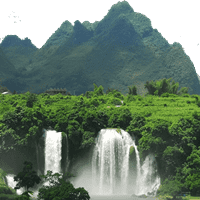 Kenya is world-renowned for its abundant wildlife and diverse landscapes, making it one of the best safari destinations on the planet. For New Zealand travelers, it offers a rare chance to explore Africa's most iconic animals and breathtaking environments. Whether you're hoping to spot the Big Five or simply experience the magic of the African savannah, Kenya's national parks and reserves deliver unforgettable encounters. Masai Mara National Reserve stands out as Kenya's premier safari destination. Located in the southwest of the country, it is home to an astonishing array of wildlife, including lions, elephants, leopards, rhinos, and buffalo. It's also the stage for the annual Great Migration, when millions of wildebeest and zebras traverse the plains in search of greener pastures. A safari here is a must-do for any first-time visitor. Amboseli National Park, near the Tanzanian border, is another top pick. With Mount Kilimanjaro as a dramatic backdrop, it offers some of the best elephant sightings in Africa. Herds of elephants roam freely, often within picture-perfect view of the snow-capped mountain. Tsavo East and Tsavo West, two massive adjoining parks, offer a wilder, less touristy experience. These parks are ideal for those seeking off-the-beaten-path adventures, with red-dust landscapes, lava flows, and sightings of rare species like the gerenuk and fringe-eared oryx. Nairobi National Park, just minutes from the capital city, provides a convenient introduction to Kenya's wildlife without venturing far. It's perfect for travelers with tight schedules or those easing into their safari journey. For New Zealanders concerned about cost, rest assured there are affordable Kenya wildlife tours for New Zealanders that still offer high-quality experiences. Group tours, off-season travel, and locally-run safari operators can significantly reduce costs while maintaining comfort and safety. Choosing mid-range lodges, tented camps, or mobile safari units can also provide unique experiences without breaking the bank. When selecting a safari park or reserve, consider what animals you most want to see and what type of landscape you prefer. Each region of Kenya offers a different flavor of adventure, from wide-open grasslands and acacia forests to swamps and rugged hills. With so much biodiversity in one country, no two safaris are ever the same. Kenya's parks and reserves promise life-changing moments, whether you're watching a pride of lions in the Masai Mara or catching the sunrise over Amboseli. Each encounter is filled with awe, from giraffes grazing against the acacia trees to herds of elephants crossing dusty plains in a rhythmic, graceful march. These experiences go beyond the visual; they stir a deep emotional connection to nature and wildlife. For New Zealanders, the journey through Kenya's untamed landscapes is an invitation to witness nature at its most raw and majestic. The early morning calls of birds, the distant roars of lions, and the golden light spilling across the savannah create scenes that are both cinematic and spiritual. There's a rhythm to life here that resonates with travelers, offering a profound escape from everyday routines. Whether you're exploring the iconic Masai Mara or venturing into the lesser-known beauty of Tsavo or Samburu, Kenya’s wild heart beats loudly and proudly. Each game drive is a new chapter, every animal sighting a fresh thrill. The diversity of terrain and wildlife ensures that no two safaris are the same. For New Zealanders looking to dive deep into Africa's wild heart, Kenya delivers on every front with authenticity, wonder, and memories that linger long after the trip ends.
Kenya is world-renowned for its abundant wildlife and diverse landscapes, making it one of the best safari destinations on the planet. For New Zealand travelers, it offers a rare chance to explore Africa's most iconic animals and breathtaking environments. Whether you're hoping to spot the Big Five or simply experience the magic of the African savannah, Kenya's national parks and reserves deliver unforgettable encounters. Masai Mara National Reserve stands out as Kenya's premier safari destination. Located in the southwest of the country, it is home to an astonishing array of wildlife, including lions, elephants, leopards, rhinos, and buffalo. It's also the stage for the annual Great Migration, when millions of wildebeest and zebras traverse the plains in search of greener pastures. A safari here is a must-do for any first-time visitor. Amboseli National Park, near the Tanzanian border, is another top pick. With Mount Kilimanjaro as a dramatic backdrop, it offers some of the best elephant sightings in Africa. Herds of elephants roam freely, often within picture-perfect view of the snow-capped mountain. Tsavo East and Tsavo West, two massive adjoining parks, offer a wilder, less touristy experience. These parks are ideal for those seeking off-the-beaten-path adventures, with red-dust landscapes, lava flows, and sightings of rare species like the gerenuk and fringe-eared oryx. Nairobi National Park, just minutes from the capital city, provides a convenient introduction to Kenya's wildlife without venturing far. It's perfect for travelers with tight schedules or those easing into their safari journey. For New Zealanders concerned about cost, rest assured there are affordable Kenya wildlife tours for New Zealanders that still offer high-quality experiences. Group tours, off-season travel, and locally-run safari operators can significantly reduce costs while maintaining comfort and safety. Choosing mid-range lodges, tented camps, or mobile safari units can also provide unique experiences without breaking the bank. When selecting a safari park or reserve, consider what animals you most want to see and what type of landscape you prefer. Each region of Kenya offers a different flavor of adventure, from wide-open grasslands and acacia forests to swamps and rugged hills. With so much biodiversity in one country, no two safaris are ever the same. Kenya's parks and reserves promise life-changing moments, whether you're watching a pride of lions in the Masai Mara or catching the sunrise over Amboseli. Each encounter is filled with awe, from giraffes grazing against the acacia trees to herds of elephants crossing dusty plains in a rhythmic, graceful march. These experiences go beyond the visual; they stir a deep emotional connection to nature and wildlife. For New Zealanders, the journey through Kenya's untamed landscapes is an invitation to witness nature at its most raw and majestic. The early morning calls of birds, the distant roars of lions, and the golden light spilling across the savannah create scenes that are both cinematic and spiritual. There's a rhythm to life here that resonates with travelers, offering a profound escape from everyday routines. Whether you're exploring the iconic Masai Mara or venturing into the lesser-known beauty of Tsavo or Samburu, Kenya’s wild heart beats loudly and proudly. Each game drive is a new chapter, every animal sighting a fresh thrill. The diversity of terrain and wildlife ensures that no two safaris are the same. For New Zealanders looking to dive deep into Africa's wild heart, Kenya delivers on every front with authenticity, wonder, and memories that linger long after the trip ends.
Where Can New Zealand Visitors See the Big Five in Kenya?
Seeing the Big Five lion, elephant, leopard, rhinoceros, and Cape buffalo in the wild is a bucket-list dream for many New Zealand travelers. Kenya is one of the best places in the world to witness these majestic animals in their natural habitat. With a mix of national parks, private conservancies, and game reserves, visitors have multiple opportunities to enjoy close encounters with the Big Five. Here are some of the best locations to visit:
- Masai Mara National Reserve: This iconic reserve is arguably the best place in Kenya to see all members of the Big Five, especially during the Great Migration. Its vast open plains make it easier to spot lions lounging under acacia trees or cheetahs stalking prey. Guided game drives increase the chance of encountering elusive leopards and rhinos, particularly in private conservancies bordering the park.
- Amboseli National Park: Famous for its massive elephant herds and panoramic views of Mount Kilimanjaro, Amboseli offers excellent chances to spot elephants up close. Buffaloes are also common here, and predators like lions and leopards roam the area. The dry terrain keeps vegetation low, making it easier to observe wildlife during early morning or late afternoon drives.
- Tsavo East and Tsavo West National Parks: These two parks make up one of Kenya’s largest protected wildlife areas. Tsavo is known for its red-dusted elephants and remote, wild landscapes. Though leopards and rhinos are more challenging to spot, dedicated visitors often find these majestic creatures in Tsavo’s quieter regions. Buffaloes and lions are frequently seen in both parks.
- Lake Nakuru National Park: While it may not host all members of the Big Five regularly, Lake Nakuru is one of the best places to see both black and white rhinos. The park’s compact size increases the likelihood of rhino sightings, and it also hosts lions, leopards, and large herds of buffalo. Its lush scenery adds a unique backdrop to any game drive.
- Laikipia Conservancies: Located north of Mount Kenya, Laikipia is a network of private conservancies offering exclusive safari experiences. These conservancies often have well-managed rhino conservation programs, giving travelers a higher chance to see both black and white rhinos. The region also supports a healthy population of leopards, elephants, and buffaloes, with fewer tourists and more personalized wildlife experiences.
Each of these parks and reserves provides a unique safari experience, increasing the odds of ticking off all five iconic species while immersing yourself in Kenya’s incredible natural beauty.
Kenya Travel Requirements and Tips for New Zealand Citizens
Planning a trip to Kenya from New Zealand involves a few essential steps to ensure a smooth and enjoyable experience. The first and most important requirement is obtaining a visa. New Zealand citizens must apply for an eVisa before traveling to Kenya. The process is relatively straightforward and can be completed online through the official Kenyan eVisa portal. It is recommended to apply at least two weeks in advance of your intended travel date to allow ample processing time. Your passport should be valid for at least six months from your date of entry into Kenya. Immigration officials may also request proof of a return or onward ticket. Once approved, your eVisa allows for a stay of up to 90 days in Kenya. Always carry a printed or digital copy of your visa and passport while traveling within the country. Health precautions are also a key part of travel preparation. A yellow fever vaccination certificate is strongly recommended, especially if you are transiting through or arriving from a country with a risk of yellow fever transmission. Routine immunizations such as measles, hepatitis A and B, and typhoid are also advised. Carry mosquito repellent and take malaria prevention precautions, especially if you plan to visit rural or high-risk areas. Another tip for New Zealand travelers is to stay hydrated with bottled or filtered water and avoid consuming raw foods from street vendors. While Kenya offers world-class hospitality, taking basic health and safety measures ensures you can fully enjoy the journey. Consider registering with New Zealand’s SafeTravel website before departure. This allows your government to reach you in case of an emergency. It's also helpful to have local emergency numbers and embassy contacts saved in your phone. Currency in Kenya is the Kenyan Shilling (KES). While major credit cards are accepted in cities and larger hotels, carrying cash is useful for smaller purchases in rural areas. ATMs are widely available in urban centers. Tipping is customary in the tourism industry, and small gratuities are appreciated for good service. Understanding local customs and laws can also enhance your visit. Dress modestly, especially in rural and religious areas, and always ask for permission before photographing people. Learning a few basic phrases in Swahili can go a long way in making local connections and showing respect. Knowing the New Zealand passport visa requirements for Kenya, taking the necessary health precautions, and being mindful of cultural practices will help create a safe and rewarding travel experience. For example, travelers should always keep digital and printed copies of their travel documents accessible throughout their journey. While navigating airports, lodges, and safari checkpoints, quick access to these documents helps ensure smooth transitions and minimizes unnecessary stress. Equally important is adapting to Kenya’s cultural norms. From tipping guides and drivers to greeting locals with respectful gestures, cultural sensitivity goes a long way. Many Kenyans appreciate when travelers make an effort to speak basic Swahili phrases or show interest in their customs. It creates positive interactions and opens doors to deeper cultural immersion. In terms of health, being proactive rather than reactive can make a significant difference. Carrying a basic medical kit, staying current on vaccinations, and being mindful of food and water hygiene all contribute to a healthy travel experience. Knowing what to do in case of illness or emergency is also key familiarize yourself with local healthcare options and keep emergency contacts readily available. All these considerations together allow New Zealand travelers to not only enjoy Kenya's beauty but also to do so with confidence and peace of mind.
What Do New Zealand Travelers Need to Enter Kenya?
Before embarking on a Kenyan adventure, New Zealand travelers must ensure they meet specific entry requirements for a smooth and enjoyable journey. While Kenya warmly welcomes tourists, it's essential to be prepared with the correct travel documents, vaccinations, and safety knowledge. Below are key entry essentials explained to help travelers plan with confidence:
- Visa Application: New Zealand citizens need an eVisa to enter Kenya. This must be applied for online before travel, using the official Kenyan eVisa portal. It's best to apply at least two weeks before departure to allow time for processing.
- Passport Validity: Ensure your passport is valid for at least six months from your arrival date in Kenya. Immigration may also request proof of a return or onward ticket. Carrying printed and digital copies of your documents is highly recommended.
- Vaccinations and Health Requirements: A yellow fever vaccination is advised, particularly if you're arriving from or transiting through high-risk countries. Other recommended vaccines include hepatitis A and B, typhoid, and measles. Pack mosquito repellent and consider malaria prophylaxis if visiting rural or high-risk regions.
- Water and Food Safety: Stick to bottled or filtered water throughout your stay. Avoid raw foods from street vendors and opt for well-cooked meals. These precautions reduce the risk of common travel-related illnesses and help ensure a comfortable trip.
- Travel Registration and Contacts: Register your trip on New Zealand's SafeTravel website for important updates. Also, save emergency contacts, such as the New Zealand High Commission in Nairobi and local healthcare providers, on your phone.
Staying informed and organized helps New Zealand travelers explore Kenya with ease and peace of mind. By preparing in advance, travelers can navigate airports, safari lodges, and border checks without unnecessary stress. Keeping digital backups of key documents like eVisas, insurance policies, and medical records can prove invaluable in emergencies. It's also helpful to set up mobile banking access, save important contacts, and familiarize yourself with local transportation options. With thoughtful preparation, your Kenyan journey becomes not only smooth but truly enriching and worry-free from start to finish.
Cultural Experiences and Local Wonders for New Zealand Tourists
 Kenya is not only a haven for wildlife enthusiasts but also a treasure trove of cultural experiences that resonate deeply with curious travelers. For New Zealand visitors, the opportunity to connect with Kenya's people, history, cuisine, and traditions adds an enriching layer to the classic safari itinerary. These interactions bring the heart and soul of the country to life. A visit to a traditional Maasai or Samburu village offers an authentic glimpse into Kenya's indigenous cultures. These communities welcome travelers with vibrant dances, storytelling sessions, and demonstrations of age-old customs such as fire-making, beadwork, and livestock herding. Visitors often leave with a new appreciation for these proud cultures and their symbiotic relationship with nature. Kenya’s coastal region offers a different cultural flavor. In cities like Mombasa and Lamu, Swahili culture thrives. A walk through the narrow alleys of Old Town Mombasa reveals a blend of Arab, Portuguese, and African influences. Visitors can sample Swahili dishes such as biryani, samaki wa kupaka (coconut fish), and mandazi while listening to taarab music. In Nairobi, museums like the National Museum and the Karen Blixen Museum allow travelers to step into Kenya’s colonial and pre-colonial past. Meanwhile, local markets like Maasai Market burst with color, offering handcrafted jewelry, textiles, and artwork. It's also the perfect place to engage with artisans and support local craftsmanship. The diversity of Kenya’s regions means travelers can immerse themselves in different cultural scenes from highland tea farms to pastoralist communities in the north. Festivals, music, and fashion vary widely across the country, making each destination a unique experience. By embracing cultural experiences in Kenya for New Zealanders, travel becomes more than sightseeing, it transforms into meaningful exchange. Whether you're participating in a traditional Maasai dance, attending a coastal Swahili wedding ceremony, or simply sharing stories over a cup of Kenyan chai, every moment deepens the connection between cultures. These experiences reveal Kenya as not just a place to visit, but a country to feel and understand. Visitors gain insight into the rhythms of daily life, spiritual beliefs, and family traditions that define Kenyan communities. For many New Zealanders, these authentic interactions add unexpected richness to their journey. It's not uncommon to be invited into a local home, participate in age-old rituals, or attend community celebrations. These immersive moments leave lasting impressions and foster empathy, respect, and appreciation. Cultural tourism also contributes to sustainable travel. When travelers support local guides, artisans, and homestays, they help preserve Kenya's cultural heritage and empower its communities. It creates a more equitable travel model, where experiences benefit both guests and hosts. Cultural exchange allows travelers to carry more than souvenirs home; they take away perspectives, friendships, and a deeper appreciation for the human experience. Kenya offers these gifts generously to those willing to embrace them.
Kenya is not only a haven for wildlife enthusiasts but also a treasure trove of cultural experiences that resonate deeply with curious travelers. For New Zealand visitors, the opportunity to connect with Kenya's people, history, cuisine, and traditions adds an enriching layer to the classic safari itinerary. These interactions bring the heart and soul of the country to life. A visit to a traditional Maasai or Samburu village offers an authentic glimpse into Kenya's indigenous cultures. These communities welcome travelers with vibrant dances, storytelling sessions, and demonstrations of age-old customs such as fire-making, beadwork, and livestock herding. Visitors often leave with a new appreciation for these proud cultures and their symbiotic relationship with nature. Kenya’s coastal region offers a different cultural flavor. In cities like Mombasa and Lamu, Swahili culture thrives. A walk through the narrow alleys of Old Town Mombasa reveals a blend of Arab, Portuguese, and African influences. Visitors can sample Swahili dishes such as biryani, samaki wa kupaka (coconut fish), and mandazi while listening to taarab music. In Nairobi, museums like the National Museum and the Karen Blixen Museum allow travelers to step into Kenya’s colonial and pre-colonial past. Meanwhile, local markets like Maasai Market burst with color, offering handcrafted jewelry, textiles, and artwork. It's also the perfect place to engage with artisans and support local craftsmanship. The diversity of Kenya’s regions means travelers can immerse themselves in different cultural scenes from highland tea farms to pastoralist communities in the north. Festivals, music, and fashion vary widely across the country, making each destination a unique experience. By embracing cultural experiences in Kenya for New Zealanders, travel becomes more than sightseeing, it transforms into meaningful exchange. Whether you're participating in a traditional Maasai dance, attending a coastal Swahili wedding ceremony, or simply sharing stories over a cup of Kenyan chai, every moment deepens the connection between cultures. These experiences reveal Kenya as not just a place to visit, but a country to feel and understand. Visitors gain insight into the rhythms of daily life, spiritual beliefs, and family traditions that define Kenyan communities. For many New Zealanders, these authentic interactions add unexpected richness to their journey. It's not uncommon to be invited into a local home, participate in age-old rituals, or attend community celebrations. These immersive moments leave lasting impressions and foster empathy, respect, and appreciation. Cultural tourism also contributes to sustainable travel. When travelers support local guides, artisans, and homestays, they help preserve Kenya's cultural heritage and empower its communities. It creates a more equitable travel model, where experiences benefit both guests and hosts. Cultural exchange allows travelers to carry more than souvenirs home; they take away perspectives, friendships, and a deeper appreciation for the human experience. Kenya offers these gifts generously to those willing to embrace them.
What Unique Kenya Experiences Await New Zealand Explorers?
Kenya offers more than just safaris and sun-drenched plains; it invites New Zealand explorers into a world rich with diverse landscapes, cultures, and adventures that go far beyond the ordinary. For travelers seeking meaningful experiences, Kenya is a destination that combines natural wonder with personal discovery. Each region presents a new and distinctive charm, from rugged mountain trails to ancient coastal cities. For those with a love of the outdoors, hiking Mount Kenya is a rewarding alternative to traditional safaris. As Africa’s second-highest peak, its snow-capped summit and lush forests challenge adventurers while providing breathtaking views and wildlife encounters with colobus monkeys and rare bird species. This high-altitude trek is both a physical and spiritual journey. Kenya's Indian Ocean coastline offers laid-back escapes for those seeking peace and relaxation. White sand beaches in Diani, Watamu, and Lamu blend luxury with local culture. Visitors can snorkel in marine parks, explore ancient Swahili ruins, and sail on traditional dhows at sunset. These coastal retreats offer rejuvenation and connection to centuries-old traditions. For a truly immersive experience, many New Zealanders find joy in community-based tourism. Spend time with local tribes like the Maasai or Turkana, learning about their daily lives, traditional ceremonies, and ancestral customs. These cultural exchanges create lasting memories and a deeper understanding of Kenya’s social fabric. Nairobi, Kenya's capital, is also not to be overlooked. It offers world-class dining, eclectic art galleries, and attractions like the David Sheldrick Wildlife Trust and Giraffe Centre. This urban hub adds a modern dimension to any Kenyan itinerary. From wildlife treks to beach escapes, from mountain climbs to cultural immersion, Kenya reveals its soul through every moment. Each region of the country offers a unique atmosphere, where nature and tradition meet in breathtaking harmony. Whether it's tracking lions across the Masai Mara or sipping tea with locals in a Kikuyu village, these moments create deep and lasting impressions. New Zealand explorers are not just tourists in Kenya; they become part of its rhythm, connecting with the environment and people in ways that are enriching and transformative. A sunset over Amboseli with elephants in silhouette, a child waving from a remote village, or a quiet walk through coastal mangrove forests these are the simple, powerful experiences that stay etched in memory. Many travelers find that Kenya offers a mirror into humanity itself. It allows visitors to experience joy, awe, humility, and reflection. This emotional connection is what makes travel meaningful. New Zealanders leave Kenya not only with stunning photographs but also with new perspectives and friendships. These unforgettable experiences allow New Zealand explorers to return home with stories, friendships, and a fresh appreciation for the world, enriched by the colors, sounds, and spirit of Kenya.
